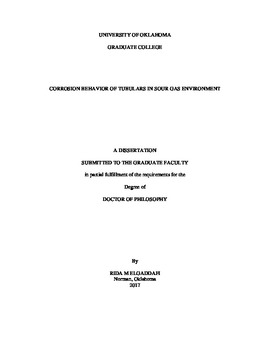| dc.description.abstract | The existence of corrosive gases (CO2 and H2S) in oil wells under High-Pressure High-Temperature (HPHT) condition exacerbates the severity of tubular corrosion and increases the need for different corrosion mitigation methods. To avoid unnecessary cost of replacement or failure in these conditions, highly reliable materials and corrosion control strategies must be developed. Corrosion attacks components of a well from drilling to abandonment stage.
The principal aim of this study is to understand electrochemical and physical mechanisms associated with CO2 and H2S corrosion of carbon steel at HPHT condition. The research approach includes experimental, theoretical and modeling studies.
Based on the theoretical studies, different corrosion models are developed to predict corrosion of carbon steel in brine saturated with mixed gas containing CO2 with or without H2S. The models are developed considering different phenomena involved in the corrosion process such as dissolution of gases, homogenous chemical reactions, mass transfer process, and electrochemical reactions. The models accounts for the effects of environmental variables such as presence of H2S, pressure, temperature; flow velocity, and material type. They use an improved solubility model to predict concentration of dissolved CO2 and other species in brine solution. Extensive experimental study has been conducted to validate the models and better understand corrosion behavior of carbon steel. Two sets of experiments were conducted during the investigation: i) low-pressure tests; and ii) high-pressure corrosion experiments. Model predictions show good agreement with experimental measurements indicating the validity of the assumptions made in the formulation of the models.
To carry out low-pressure tests, cylindrical specimens of common carbon steel (C1045) were prepared. The specimens were exposed to brine solution saturated with mixed gas containing carbon dioxide and nitrogen. Experiments were carried out in a 2-liter autoclave at 0.83 MPa varying temperature (26 – 80°C), salt concentration (1 and 2% NaCl), and CO2 partial pressure ratio (0 – 100%). Two different corrosion- measuring methods were employed: weight loss method and Linear Polarization Resistance (LPR) technique, which is used to measure instantaneous corrosion rate. In the presence of CO2, LPR measurements show sharp increase in the corrosion rate for the first ten hours, reaching maximum and then sharp decrease. Moreover, results reveal that temperature is the most influential factor affecting CO2 corrosion. The maximum corrosion rate was observed at 43°C regardless of CO2 concentration.
The high-pressure tests were aimed at investigating corrosion resistance of API carbon steels (T95, C110 and Q125) in sweet and sour environments. Specimens were cut from API casings and machined to serve as corrosion coupons and tensile strength test specimens. Water-jet cutting and milling machines were employed to manufacture the specimens with high precision and eliminate the occurrence of material defects during manufacturing. Corrosion tests were carried out by placing 2 or 3 specimens into a 2-liter autoclave, which was filled with 950 ml of 2% NaCl solution and 1050 ml mixed gas containing CO2, H2S and CH4. Sodium chloride concentration is kept as high as 2%, which stays within the range of seawater salinity and simulating formation water in the oil field (Liu et al. 2014; Hassani et al. 2011). The CO2 and CH4 concentrations were varied from 0 to 100%, while H2S concentration was varied from 0 to 150 ppm. In pure CO2 corrosion experiments, carbon dioxide displays supercritical behavior. The total pressure and test temperature were in the range of 20.68 – 62.05 MPa and 38 – 107°C, respectively. The maximum test temperature was limited to 107°C, because the corrosion rate was very low at high temperature and it was difficult to measured accurately due to limited change in specimen weight throughout the test duration (7 days).Corrosion resistance of T95 and Q125 API carbon steels was investigated under static and dynamic condition. Dynamic tests were conducted by creating a Couette flow between two concentric cylinders (outer stationary and inner rotating at a constant speed). Tests were performed varying rotational speed from 0 to1000 rpm. All experiments were carried out for one-week duration. Due to lack of electrodes that are certified for HPHT environment, weight loss method was the only technique viable to measure corrosion rate. After exposure, the specimen surface was examined using a digital microscope to inspect corrosion product and detect presence of localized corrosion. After scale examination and weight loss measurements, the specimen Load Carrying Capacity (LCC) was measured using tensile strength measuring apparatus. LCC measurement was obtained principally to assess localized corrosion, which degrades mechanical properties of a metal without significant weight loss. Experimental results show that temperature and flow velocity are highly influential parameters on sweet corrosion. Consistent with the corrosion rate measurements obtained from low-pressure tests, the maximum corrosion rate was observed at 38°C. Under the test conditions employed in this research, Q125 carbon steel exhibited the highest corrosion resistance. Therefore, it can be considered as the best option to serve in aqueous CO2-H2S environment. C110 and Q125 specimens tested at H2S concentration of 50 ppm showed considerable reduction in LCC indicating the occurrence of localized corrosion. Similar reduction in LCC was observed when T95 and Q125 carbon steels were exposed to brine saturated with mixed gas containing 50% CO2 and 50% CH4 at 71°C and high rotational speeds (greater than 300 rpm). | en_US |
